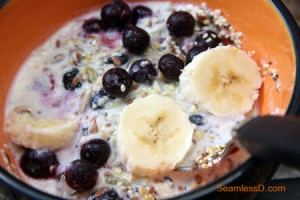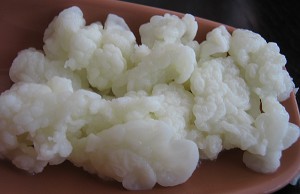Wouldn’t it be nice if today scientists discovered some miracle cure-all tucked away in a remote corner of the earth? A magic potion that would improve your mood, your digestion, your skin, joints, and overall well-being? While a full blown panacea may never be discovered, according to thousands of testimonies and recent scientific support, there actually might be a food that carries such widespread health benefits that it could be the closest we ever come to a panacea.
Both mainstream and alternative health experts agree that good health really depends on friendly bacteria flourishing inside our digestive tracts.
And we’ve all heard how yogurt can provide our bodies with good bacteria. Certainly some types do. But yogurt has a lesser known relative that you need to become familiar with.
If yogurt is a helpful fighter in the battle for health going on inside you, think of its cousin Kefir as the Chuck Norris of probiotics. And trust me, you always want Chuck on your side.
What exactly is kefir?
Kefir is a probiotic food made by mixing milk with kefir grains and left alone for a day or two to ferment and develop extremely high levels of good bacteria and yeast.
Refresh my memory…what’s a probiotic?
[A probiotic is a substance that stimulates the growth of microorganisms, especially those with beneficial properties, such as the intestinal flora]
And the kefir grains? They are a unique culture (specialized growth of bacteria) made up of casein (milk protein), yeast, bacteria, and complex carbohydrates.
Most often kefir is made by fermenting kefir grains with milk from cows, goats, or sheep, but can also be made with fruit juice, coconut water, almond milk, or soy milk (least desirable option).
If you’ve never had it, imagine milk that is slightly tangy or just a bit sour. Or a really thin plain yogurt. Sure, none of these images are going to make you salivate, but kefir combines surprisingly well with other natural foods and most consumers acquire a taste for it straight up. Mix a little in your smoothie and you’ll be hooked.
Why do we need Kefir?
Things like chlorinated tap water, gluten, refined sugars, and antibiotics create a terrible environment in your stomach and digestive tract, where bad bacteria and yeast thrive, leading to all manner of ill health. The good bacteria and yeast found in kefir combine magnificently to control these bad elements in our bodies, sometimes leading to tangible benefits in a matter of weeks.
Good bacteria and yeast in your stomach is not just the foundation of a healthy immune system…it IS your immune system!! It actually comprises about 70% of your immune system’s weaponry.
While probiotic supplements in the form of capsules are helpful and certainly more convenient, most experts agree that kefir provides a much higher volume of friendly bacteria. So feed your body the good bacteria it craves from this unique, real food source!
I like milk, but the feeling isn’t mutual! Lactose intolerance…
And there’s good news for you too, my fellow milkophobes! Many people with milk “allergies” or who are more specifically lactose intolerant experience little or no negative side effects with kefir.

Kefir poured over raw seed-based cereal with raisins, blueberries, & bananas. And you thought you’d never see a bowl of cereal again.
Lactose, a sugar that makes up 2-8% of milk, really is the primary culprit in digestive issues with dairy products. But during fermentation the kefir grains eat away most of the milk sugar. And then your final kefir milk product contains ample lactase enzymes to break down the lactose that remains after fermentation. In fact, some people’s digestion greatly improves with regular consumption of this particular dairy product.
That’s right. There is a milk product that might improve your digestion. You might want to stop and consider that for a moment if you haven’t had milk for years and feel like you’ve been missing out.
(Of course not everyone’s body reacts so perfectly. Try small amounts at first, maybe just 2 or 3 times a week and see how you do. If the cow’s milk isn’t working for you, start over with a different type of milk…even almond milk to fully steer clear of the animal products if you like). For an even easier non-dairy solution, see the water kefir recipe below.
Some Health Benefits of Kefir…
While scientific journals are now publishing positive results from this increasingly popular probiotic, people have been reporting the health benefits of kefir for generations, including improvements with:
- Digestion
- Colitis
- IBS
- Immune function, including HIV & AIDS
- Ecsema, psoriasis, and related skin disorders
- Inflammation of any type
- Cold & flu prevention
- Arthritis
- Gout
- Depression
- Energy levels
- Chronic fatigue
- Candida
- Mental alertness
- Osteoporosis and bone density
- and even Cancer
Where did kefir come from?
For centuries people of the Caucasus Mountains in Eurasia relied on this simple food for nourishment and medicinal properties. It was revered as a gift from Above and kept a secret until 1908 when a Moscow dairy company actually sent one of its more attractive workers to obtain (putting it respectfully) the kefir grains for their own widespread production. She journeyed hundreds of miles south to entice the prince in Caucasus, failed to get the grains, and headed for home.
Apparently the prince took quite a liking to this young woman and sent to have her brought back to force her hand in marriage. So her people came to her rescue and somehow they were all brought before the Tsar who ruled the prince had to give the girl ten pounds of kefir grain to compensate for his offence!
Kefir soon became very popular in Russia and now this same healing drink is enjoyed by millions around the globe. And to the attractive dairy worker who risked her life, we say Spasiba!
How to order your own kefir grains…
Can you believe how different things are today? Kefir still isn’t the easiest thing to find. But we complain because it can take nearly ten minutes to search around online for someone who’ll mail it to our front door. (Save yourself the ten minutes, just order from The Kefir Lady.)
Okay, so how do I make kefir?
The easiest way to make Milk Kefir is to:
- OBTAIN some milk kefir grains from a friend, your health food shop, or order them online.
- COMBINE them with milk in a glass jar or bowl. If you start with 1-2 tablespoons of kefir grains you might use 2 cups milk…but this ratio is fairly flexible. Give it a quick stir with a clean wooden or plastic spoon, as metal shouldn’t ever touch the ingredients.
- COVER the container for 24-48 hours at room temperature (less time if it is warm, more time if it’s cool). You can cover it with a cheesecloth with a rubber band securing it to the top of the jar to let the mixture breathe while keeping out bugs and other foreign matter. Another way is to rest a plate on top of the jar or bowl. Just be sure to use a lead-free plate (if it says made in China, it likely contains lead). You might want to stir it all up once a day with your clean wooden spoon.
And that’s it….You have just made kefir! Now we’ll save the grains to re-use for next time.
- SEPARATE most of the liquid from the grains. Just pour it through a plastic strainer. The thinner liquid portion will be your kefir to use for smoothies or however you like. Store what you don’t use right away in a sealed glass or plastic container in the fridge. This can keep for weeks.
The chunky bits left in the top part of the strainer will mainly consist of the kefir grains that you will want to save and re-use again and again! Store these in a sealed glass container at room temperature submerged in a little milk, out of bright light. Or better yet, use them to start your next batch right away to keep the cycle going. In a day or two you might be ready for more.
You also might want to know…
- Raw organic milk is a favorite, but other types can certainly be used. Look for organic, and try to avoid ultra heat treated milk.
- A kefir “starter kit” has benefits but isn’t quite the same thing. Most people recommend getting proper kefir grains from someone who has their own and will share them with you or sell some of what they have, because they do grow and multiply.
- Metal clasps on the outside of a glass jar won’t harm the mix (the kind that lock the glass lid into place), but a metal/tin lid should be avoided. A plastic, airtight container would be a better choice when a glass solution isn’t available.
- Try mixing with berries, granola, smoothies, stevia, honey, agave nectar, or whatever you like!
Making Water Kefir
- 1/4 cup kefir grains
- 1/3 cup white cane sugar (& optional 2 tablespoons turbinado sugar)
- 4 cups clean water
- 4 slices of fresh pear or apple
- 3 little chunks of ginger
3. Gently stir these ingredients.
4. Put the lid back on the jar and store in a dark space for 48 hours.
Even easier…Apple Juice Kefir
Here’s to your health!
